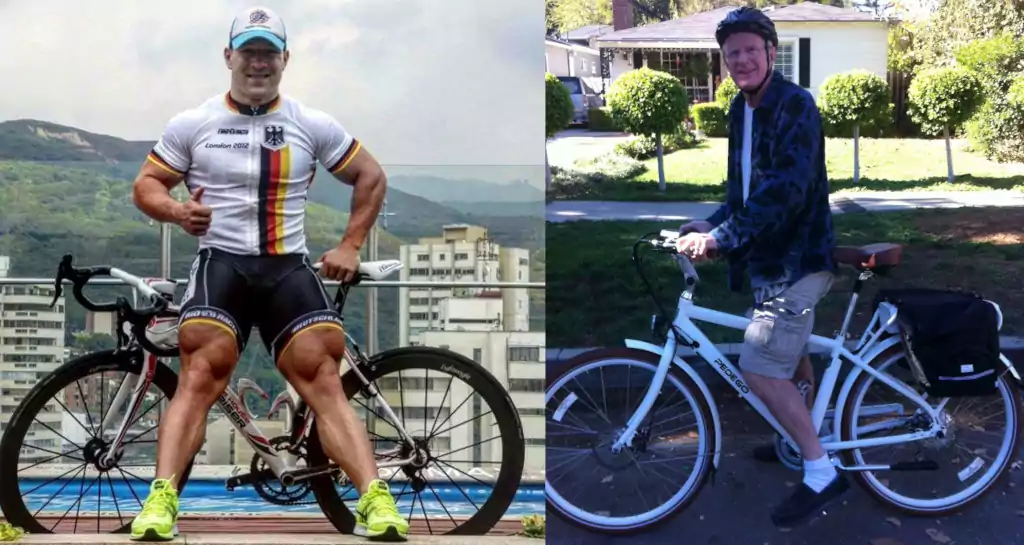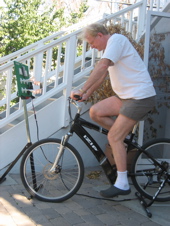The Difference Between Energy and Power

The terms "energy" and "power" are often confused, especially in articles by journalists who should know better. Knowing the difference between these two terms is critical to making good energy-related decisions. Here's what the two terms mean, why they are often confused, and an example showing why the distinction is important.
Energy vs Power
Energy is the capacity to do work. It exists in many different forms, including:
- chemical energy
- kinetic energy
- gravitational energy
- thermal energy
- radiant energy
- electrical energy
Energy usually has to be converted from one form to another to do something useful. Often several conversions are required. In a pedal-powered generator for instance, you metabolize food (chemical energy) to fuel your muscles and maintain body temperature (heat energy). Your leg muscles spin a generator (kinetic energy) that generates electricity (electrical energy). That electrical energy, in turn, might be used to power a lamp (radiant energy), run a cooling fan (kinetic energy), or recharge your phone's battery (chemical energy).
The crucial distinction about energy is that it is a quantity defined by a single measurable property, like length, weight, or volume.
The international measurement unit for energy is the joule (J)[1]. One joule is roughly the amount of energy required to raise the temperature of 1/4 gram of water one degree Celsius. Large amounts of energy are measured in kilojoules (kJ), where 1 kJ = 1000 J. One US food calorie is 4.19 kJ.
Power, on the other hand, measures the rate at which energy is converted or transferred. A rate measures how much something changes with time. It is the ratio between a quantity (in this case energy) and time:
P = E / t
where:
P = power
E = energy
t = time
Similar rate quantities include speed (distance/time) or flow rate (weight/time or volume/time).
Power is measured most often in watts (W) or kilowatts (kW), where 1 W = 1 joule/second and 1 kW = 1000 W.
Many devices produce or consume energy at a constant rate. Rewriting the power equation shows that the total energy delivered for such a device is the power multiplied by the length of time it is used.
E = P x t
Consequently, energy is often expressed in units of power multiplied by time. The most common unit is the watt hour, abbreviated as Whr, Wh, or W-hr. A power of 1 watt delivered for 1 hour is 1 Wh or 3600 J (1 Wh = 1 J/second * 3600 seconds/hour = 3600 J). A kWh is 1000 Wh.
Why Power and Energy are Confused
These two units--watts and watt hours--are why power and energy are so frequently mixed up.
Most rates are measured in units with an explicit time reference in their denominator (e.g., miles per hour, kilometers per hour, or cubic feet per minute). A watt, however, does not have a "per hour" or "per second" in it's name, so it doesn't resemble a rate.
A watt hour, on the other hand, sort of looks like a rate, since it contains a unit of time (hour) in its name. But "hour" in this case is a multiplicand, not a divisor--i.e., it is "watts times hours", not "watts per hour".
A watt hour is similar to a light-year, which is the distance an object traveling at the speed of light moves in a year. Both are quantities defined by multiplying a rate by time.
To help keep them straight, always remember that a watt is a joule per second. This makes it clear that anything expressed in watts is measuring a rate, which is power. A watt hour is then 1 joule/second x 1 hour x 3600 seconds/hour = 3600 J, or 3.6 kJ
A Useful Example
The distinction between energy and power is especially significant when using a pedal-powered generator. Here's an example that shows why.
There's a famous YouTube video that shows Olympic track cyclist Robert Förstemann attempting to make toast using a human-powered generator.
He can't do it.

(source: KCRW)
Yet, actor and environmental activist Ed Begley Jr is famous for using a bicycle-powered generator (right) to make toast on his reality TV show.
How can a nerdy guy like Ed Begley make his own toast, while a world-class athlete like Robert Förstemann can't?
Electrical devices like a toaster are designed to operate at a specific voltage and current (amperage). The power such a device consumes in watts is the product of its operating voltage (measured in volts) and current draw (measured in amps).
P = V x A
where:
P = power
V = volts
A = amps
This means every electrical device needs a minimum amount of power to operate properly. For the toaster in Robert's video, this was about 700 W. In other words, a toaster needs energy delivered to it at a rate of 700 J every second to toast one or two slices of bread. If it receives less power than this, it won't generate enough radiant heat to toast the bread.
But very few humans can produce 700 W of power; those who can are able to do so for a short period of time. That's why Robert is ultimately unsuccessful at making toast.
So how then is Ed able to power his toaster?
Using a Battery as a Power Adapter
Ed doesn't power his toaster directly like Robert tried. Instead, he stores the electricity from his pedal-powered generator in storage batteries attached to his home's solar panels. He then uses this stored energy to power his toaster.
Ed is using his battery as a sort of power adapter. A battery can store electrical energy at one rate and release it at a different rate. Since energy can't be created or destroyed, the total energy going into a battery must equal the energy going out.
In Ed's show, he pedaled hard for 15 minutes to store enough energy for his toaster to make toast. His toaster then took 2.5 minutes to toast his bread. If Ed's toaster draws 700 W like the one in the video, the total energy his toaster drew from the battery would be:
E = P x t = 700 W x 2.5 minutes x (1 hr / 60 minutes) = 29.2 Whr
If Ed's battery system were 100% efficient, then Ed's power output would need to be:
P = E / t = 29.2 Whr / 15 min x (60 min / 1 hr) = 117 W
A more reasonable value for the efficiency of his battery system would be 90%. Using this value, Ed's power output would need to be 117 W / 0.9, or about 130 W. This seems plausible for a guy like Ed--and a whole lot less than 700 W [2].
This example shows the important difference between power and energy. Robert couldn't make toast because he couldn't maintain his power output for a long enough period becoming exhausted. Ed succeeded because he pedaled at a lower, more sustainable power output over a longer period of time, which generated more total energy. Ed stored this energy in a battery, which had the capacity to deliver more power to the toaster over a longer period than either Ed or Robert.
1. In the United States, heat energy is often measured in British Thermal Units (BTU), while food energy is measured in kilocalories (kcal). 1 BTU = 1.055 kJ and 1 kcal = 4.184 kJ. The "calories" unit displayed on US food labels is actually a kcal. (back)
2. Ed's battery stores energy at a low rate over a long time period and releasing it at a high rate over a short period. But a battery can also store energy at a high rate and release it at a slower rate. That's how I power this web site--I pedal for 3 hours a day, then use the energy stored to power our web server and network equipment the remaining 21 hours.(back)